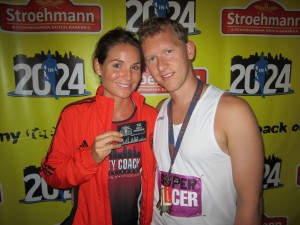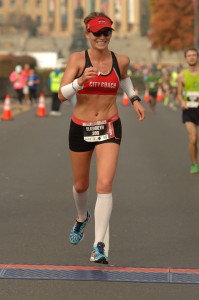It’s a funny thing to be on the edge of your goal-race. I have been open in the past about how hard tapering can be, and how personally I don’t handle the anxiety well. I suppose this makes me a sympathetic and understanding coach – which is a good thing. As an athlete though, I do not love it. I am under two weeks away from my 100-mile goal in the Back on my Feet 24-hour race. Unlike a 10K or marathon, where my nerves are more about pacing, embracing the pain of working hard, fueling smart, using as little energy as possible, and visualizing the course and how I’ll feel, there’s more to a 24-hour race. Yes, I am also focusing on nutrition, pacing, etc., but the truth is, I have yet to ever run close to 100 miles within 24 hours. Attempting to do so when temperatures may reach 90-100 degrees – that makes me very nervous. Terrified, even.
I guess what’s different about this race is that failing to achieve my goal would be the result of something going terribly wrong. Usually when I fail to achieve a time goal in a Half Marathon or Marathon, it’s not because I end up in a medical tent with IVs in my arm. Usually those failures are due to my head simply not being in the game, going out too fast, less than idea temperatures for racing, a bad morning – while these things suck and can certainly be defeating, I have always walked away from those races knowing it wasn’t my day. That I could take another crack at it. That I was stronger than that. In the back of my mind I question if I am physically and mentally capable of ever covering 100 miles within 24 hours.
I give myself the same pre-race advice I give my athletes: I have a plan for race day, and I plan to stick with it unless I need to be even more conservative. I am trusting my training. I have run my highest-mileage weeks ever within the last 6 weeks, and I should trust how well I handled that. I am not injured, which for many of us is a huge asset pre-race. I’d be the first to admit that I’ve run a dozen or so races on legs or feet that weren’t near 100%. I have secondary goals, though I REALLY want that 100+ mile goal. But, since I cannot control the weather, it could be a day where everyone struggles for a triple-digit race, and so I may need to adjust my goals. My race is between myself, the clock, and doing better than I did at this race in 2012. I am not going to allow myself to compare myself or compete with anyone on the course until I make it to 100 miles. If I get to 100 miles and still feel okay enough to press on, I may plan to chase after the ladies in front of me, but first I need to get to 100 miles for myself. I am also reminding myself that as large and epic as this race goal may be to me, it is not the end of the world. No matter what happens on July 19-20th, I will have future races if I want them. I am focusing on how grateful I am to have an awesome support system of family and friends on my team. I am thankful to be able to draw on their strength, energy and motivation when I want to give up.
If you have a goal race on the horizon, remember that nerves can be a good thing. It means you care. Just don’t let your nerves break you down. When the gun goes off and you put one foot in front of the other, your mind and body will relax. It always happens. It’s often just a matter of getting through the taper and to the starting line.
I am terrified of race day. I want to cry, and scream and have a dance party all at the same time. I’ve questioned my sanity. I respect the challenge and realize it should be feared. But I am also excited and almost giddy. Is there anything that makes you feel more aline than extreme joy and pain? In a race, we are lucky enough to feel perhaps more alive than ever.










